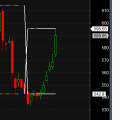One of the more important themes we have discussed before is the need for traders (especially the newbies) to focus on the process rather than the profits.
The idea is that a good, disciplined trader could always turn the odds in his favor if he has honed his skills enough to deal with whatever scenario is thrown his way.
But becoming a better trader is not as easy as reading the School of Pipsology and then taking as many trades as you can with the hope that experience will teach you the way to profitability.
In fact, many traders can’t even move on from one or two issues that they’d like to address let alone improve their skill sets.
If you find yourself having to work on the same set of trading issues or problems month after month or year after year, then you might be guilty of one of the scenarios below:
1. You don’t have concrete plans to address them.
Remember that a goal without a plan is just a wish. Solutions to your trading problems should not be like your New Year’s resolutions that you forget about almost as soon as you write them in your journal.
Whether it’s something as simple as not placing stops or jumping on a trend too early or something more complicated as cutting winners and letting losers run, you have to have concrete plans if you want to successfully battle your trading issues.
Set trading goals that work. List down concrete steps you can take and set a schedule to make sure you follow them through. Set metrics to help you gauge your success if that helps.
2. You’re not actively thinking about it.
You can have the most detailed game plan but still fail to meet your trading goals if you don’t consciously work on them with every trade.
Let’s say you’ve decided to base your position sizes on your account balance instead of using fixed units. Your plan is to compute for each position before entering a trade. You give yourself a pat on the back because you manage to do it for a week.
But suddenly, an intraday trade opportunity popped up and you’ve chosen to fall back into the habit of setting fixed position sizes rather than miss the move.
You probably thought “Eh, I’ll just go back to working on my goal in my next trades.” And, because you won your trade, you’ll think “no harm done” and likely do it again in the future.
These little cheats and breaks that you give yourself might not affect you in the short term, but they will eventually add up to break your momentum. The next thing you know, you’ll be listing “use dynamic position sizes” in your goals again next year.
3. You’re not tracking your progress.
Perhaps the most common reason you can’t address your trading issues or meet your goals is that you’re not tracking them.
Just like chefs list down the adjustments that they make in their recipes, you should also track and evaluate your progress.
What have you done so far? Are you closer to your goal today than you were a couple of weeks ago? Which factors help and which ones should you watch out for? How can you improve faster? A trading journal is perfect for this purpose.
Regularly revisiting your progress not only gives you a “cheat sheet” in case you slip and fall back into old habits, but it also helps put your trading goals in your thought process when you trade.
Remember that trading is a marathon and not a sprint.
If you want to trade for another day until you become consistently profitable, you must learn how to successfully address your trading issues and get into the habit of working on (and meeting) your trading goals.



